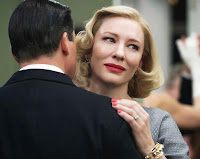I loved director Todd Haynes’
Far From Heaven (2002) and
I’m Not There (2007), Cate Blanchett is one of the supreme actresses of world cinema, I’ve enjoyed many of Patricia Highsmith’s novels, and Cincinnati-Northern Kentucky is an unheralded, but pretty wonderful place to live; and despite all of that,
Carol is a beautiful cinematic corpse. It reminded me of Antonioni’s
L’Eclisse (1962), which as a series of stills or short scenes without dialogue was gorgeous, but had no thematic meaning for me because it didn’t seem to be linked to a plot. Writers had lauded it for over a quarter century so I thought I was just missing something. Some have already handed Haynes a backhanded compliment by writing that
Carol has the heart his earlier work lacked; I couldn’t disagree more.
 |
| Rooney Mara |
For some reason, Rooney Mara is a big deal right now. She resembles Audrey Hepburn in the early Greenwich Village scenes of
Funny Face (1957), but she has none of that incandescent star’s expressiveness. In Highsmith’s
The Price of Salt (1952), upon which this is based, the main character Therese is in her early twenties and trying to figure out her
identity. She does so through a romantic relationship with Carol, a wealthy suburban housewife and mother. Mara comes across as tentative; by the time she may have decided which emotion(s) to project, the movie has cut to the next
 |
| Blanchett's Demeanor |
scene. Blanchett works in a style that seems to merge her own technique with something out of ‘50s MGM, almost as if she’s resurrecting Eleanor Parker with a mellifluous voice, a glamorous, professional demeanor, and discretion about honest feelings. While an intriguing choice, it doesn’t provide any connection with Mara, which is fatal. If the lovers don’t spark, then the love story doesn’t work and that’s what happens here.
 |
| Cate Blanchett |
Blanchett’s scene with Sarah Paulson as Carol’s long-time friend when their hands meet as they walk downstairs made me wish they’d ended up together. Kyle Chandler as Carol’s husband Harge also displays a passion that briefly breaks the movie’s placid, elegant demeanor. He looks a little like John Hodiak, but he’s more powerful and expressive. Jake Lacy, charming with Jenny Slate in last year’s
Obvious Child, has a wide-eyed innocence as Richard, Therese’s boyfriend who cannot emotionally grasp the situation. Local pros Amy Warner and Michael Haney nail their scene as Harge’s conventional, wealthier parents. Neil recognized Deb Girdler’s voice as the motel clerk in one significant scene.
 |
| Leachman's Cinematography |
Edward Lachman’s cinematography displays the beauty of Cincinnati as well as the automobiles, clothes, and interiors of the post-World War II era, but at times its embarrassment of riches goes against the storytelling. There’s an extraordinary reflection shot in a motel office’s window that shows an important piece of information, but I found my attention arrested by the shot and how it was done, rather than what was happening. There are a number of instances where the camera lingers over various objects to a degree that is fetishistic. Haynes seems more obsessed and aroused by the signifiers of that era, rather than the characters –especially those of Carol and Therese – in the plot.







No comments:
Post a Comment